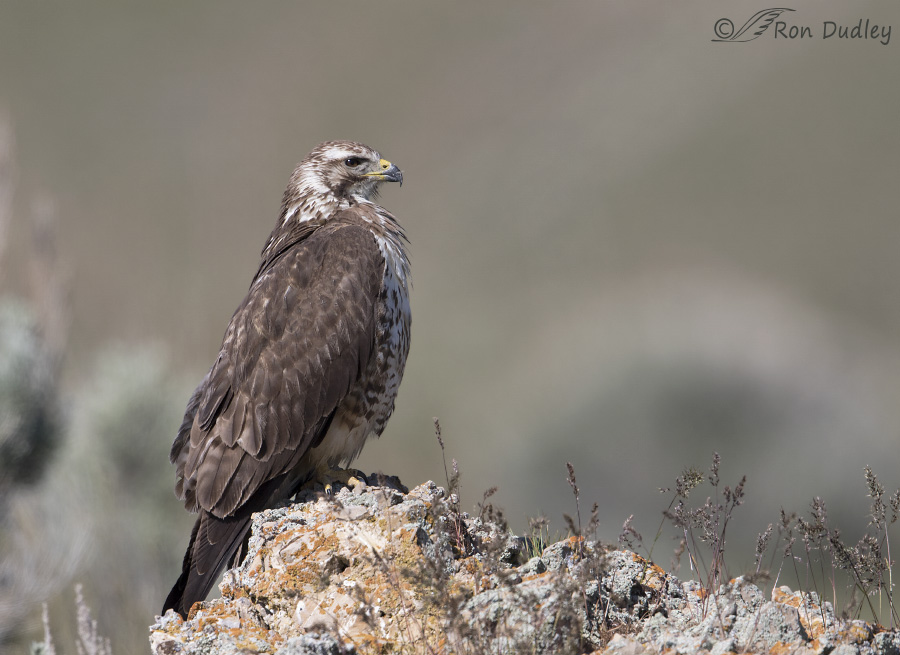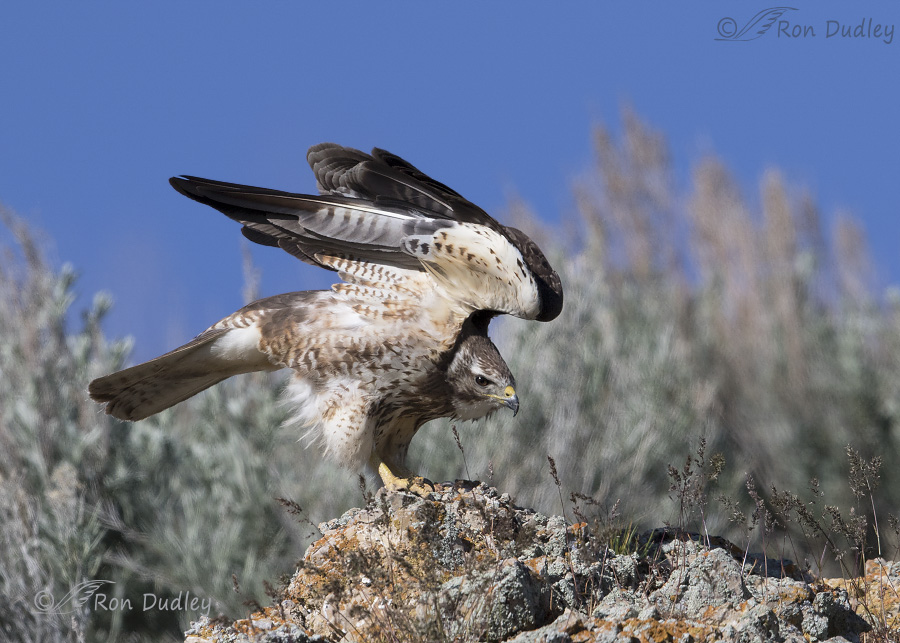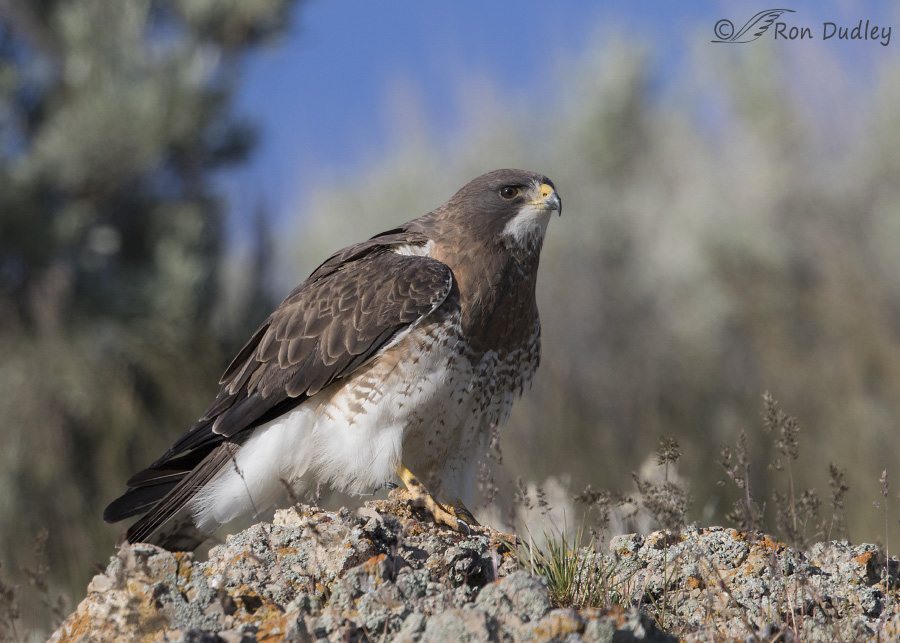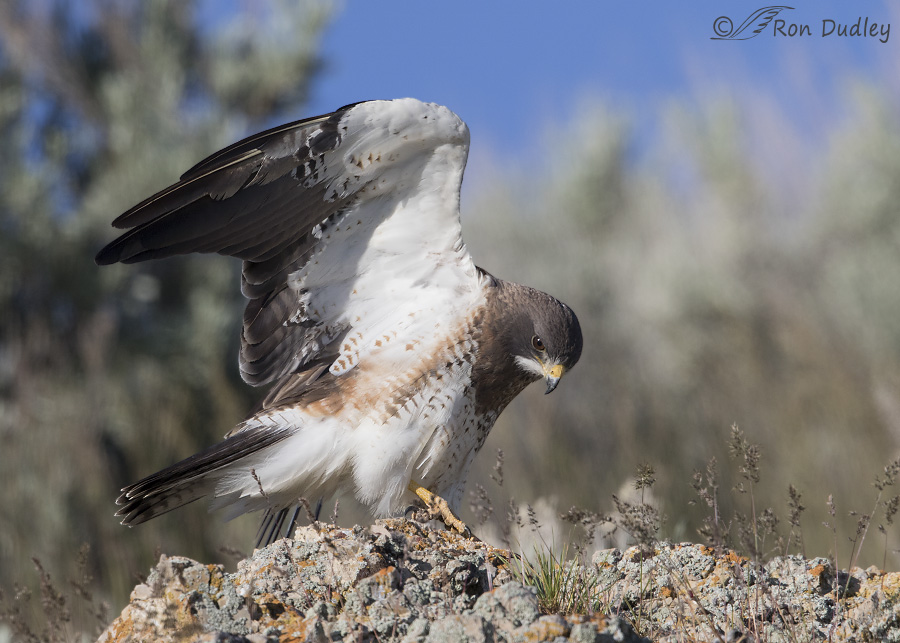It’s my intention to finally post the series of images I took of these two hawks as they mated but there are too many photos that I want to include for a single post. So this morning I’ll “introduce” the two birds and include some preliminary background and then post the mating sequence tomorrow.
I first noticed these birds weeks ago when they were building their nest in a tree near a ranch house but after the nest was completed nothing happened for quite a while. Both birds continued to hang around the area but they mostly stayed away from the nest (as always I never approached the nest). Then four days ago I photographed them as they mated and now it appears that they’re incubating eggs.

1/1250, f/6.3, ISO 250, Canon 7D Mark II, Canon EF 500mm f/4L IS II USM + 1.4 tc, not baited, set up or called in
The male and female don’t look very much alike. This is the female, a young light morph Swainson’s. Both hawks are fond of this rocky perch but the female seems to have a particular attachment to it (the male spends much of his time on a nearby power pole). On one morning the female, over a period of about three hours, was perched here every time I drove by.

1/3200, f/6.3, ISO 250, Canon 7D Mark II, Canon EF 500mm f/4L IS II USM, not baited, set up or called in
One morning she gave me a nice wing lift before she took off. No matter what she was doing I thought she always had a rather stern look about her.
Oops, I just now noticed that I didn’t place my copyright logo carefully. I’ll have to fix that – sometime…

1/2500, f/6.3, ISO 500, Canon 7D Mark II, Canon EF 500mm f/4L IS II USM + 1.4 tc, not baited, set up or called in
This is the handsome male of the pair – a light morph adult. This is one of the relatively few times I saw him perched on the craggy rock preferred by the female.

1/2500, f/6.3, ISO 500, Canon 7D Mark II, Canon EF 500mm f/4L IS II USM + 1.4 tc, not baited, set up or called in
One morning I noticed him flying in to the rocky perch so I pre-focused on it and caught him with his wings up just after he landed. As you can imagine the bright whites under his wings present a rather daunting exposure problem in strong light.
Ok, tomorrow it’s my plan to post the mating series. It was the closest I’ve ever been to copulating buteos and completely unexpected so I wasn’t prepared for the situation but I was still able to get some interesting images.
I hope you enjoy them.
Ron


Hello Ron. So jealous!!! Such great photography!!!! You photograph and study many birds. Any idea why swainsons have they’re brood so late in the year?? Even ospreys have been sitting already. I have 3 swainsons nests near me and they are just taking they’re time.
I’m not sure, Marina. Perhaps it’s related to the time it takes for them to get here from South America during their spring migration.
Ron, great shot of the leggings, so full. Both birds are my Monday morning gift. Thank you for the time you spend noting and culling. Diana
Beautiful Photos, isn’t it amazing the wide coloration difference in Swainson’s Hawks.
Ooooh.
And ahhh.
🙂
Superb photographs! That male is one handsome bird!
He is exactly that, Wally. Thank you.
Beautiful hawks! Beautiful photography! Makes me want to buy a pickup and move to Utah. Thanks, John
We have pretty good numbers of raptors here at some times of the year, John. Other birds too.
These are gorgeous birds. I’m looking forward to the mating sequence. And your misplaced copyright gave me a good laugh…
I hate it when I do dumb stuff like that, Susan. My mistakes are soooooo….. public!
These beautiful images show some wonderful feather detail…make me wonder, again, where those mystery feathers in the previous mating sequence came from….did you ever figure it out?
Not for sure, Patty but I guess they could only be the tail of the male, bent at a ridiculous angle.
Great shots of a beautiful hawk. It is interesting that this species has several color morphs. Do you find that various color morphs stay with the same morphs, e.g. when they mate, or do they intergrade?
You wouldn’t think that a good sized hawk would be going after insects, but according to everything I’ve read, grasshoppers, caterpillars and small mammals are its fare. Probably why it is a grassland hawk.
Dick, no, they don’t “stay with the same morphs” when choosing mates. In my experience more often than not the morphs of a pair are different. Last summer (or maybe the summer before) in Montana I saw (and photographed) an obviously mated pair where one was a dark morph and one was a light morph. That was quite a contrast in a breeding pair, they looked so very different from each other that you’d almost wonder if they could be the same species…
During the breeding season the diet of this species is mostly mammals but other times of the year they switch over to insects.
As you’ll see tomorrow I photographed this male eating a road-killed rabbit – first time I’ve ever seen that happen with this species. He carried the rabbit from the road and flew with it to a fence post where he was eating it.
Just gorgeous shots, Ron–I especially liked the close look at the underwings of both birds. In addition to the “stern” look of the female, I noticed that the condition of
her feathers in general was rather raggedy in comparison to the male , whose leggings in particular were magnificent . It’s common for mothers of many species of
animal to look physically drained and scruffy, but this one isn’t a mother, yet…….made me wonder if something about preparation for mating and gestation is also
physically demanding ?
Kris, she’s a young bird and not very experienced or efficient in many of her activities so perhaps that has something to do with it.
The nest is in a spot in the tree that has many branches all around it and she made innumerable trips to the nest with sticks in her bill while it was being constructed. Perhaps her plumage took a beating with all those flights in and out of the nest.
I’m only speculating of course…
What beautiful raptors…and photos. Thank you Ron.
I’m glad you enjoyed them, Zaphir. Thanks.
Wonderful shots and commentary – contrast is always a challenge! 🙂 Looking forward to the series. 🙂
“contrast is always a challenge”
Yes, it is, Judy – especially with some raptors. Your exposure looks good while they’re perched but when those wings come up everything changes. I hate seeing the “blinkies” on my camera screen when I preview those types of images!
Your blinkies comment made me laugh. My son set my camera up to flash over exposed areas after I complained of blowing out my whites. I let a friend barrow my camera for a few shots and she thought she had broken my camera when she looked at her photo and saw flashing black.
Great shots Ron! I can’t wait for the next sequence!
Charlotte
Thank you, Charlotte.